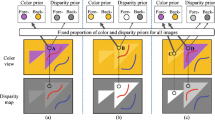Abstract
We cast the problem of multiframe stereo reconstruction of a smooth shape as the global region segmentation of a collection of images of the scene. Dually, the problem of segmenting multiple calibrated images of an object becomes that of estimating the solid shape that gives rise to such images. We assume that the radiance of the scene results in piecewise homogeneous image statistics. This simplifying assumption covers Lambertian scenes with constant albedo as well as fine homogeneous textures, which are known challenges to stereo algorithms based on local correspondence. We pose the segmentation problem within a variational framework, and use fast level set methods to find the optimal solution numerically. Our algorithm does not work in the presence of strong photometric features, where traditional reconstruction algorithms do. It enjoys significant robustness to noise under the assumptions it is designed for.
Similar content being viewed by others
References
Blake, A. and Yuille, A. 1992. Active Vision. MIT Press: Cambridge, MA.
Caselles, V., Catte, F., Coll, T., and Dibos, F. 1993. Ageometric model for active contours in image processing, Numerische Mathematik, 66:1–31.
Caselles, V., Kimmel, R., and Sapiro, G. 1997. Geodesic snakes, Int. J. Computer Vision, 22(1):61–79.
Chakraborty, A. and Duncan, J. 1999. Game-theoretic integration for image segmentation, IEEE Trans. Pattern Anal. Machine Intell., 21(1):12–30.
Chakraborty, A., Staib, L., and Duncan, J. 1996. Deformable boundary finding in medical images by integrating gradient and region information, IEEE Trans. Medical Imaging, 15(6):859–870.
Chan, T. and Vese, L. 1999. An active contours model without edges, Int. Conf. Scale-Space Theories in Computer Vision, pp. 141–151.
Cipolla, R. and Blake, A. 1992. Surface shape from the deformation of apparent contours. Int. J. of Computer Vision, 9(2).
Cohen, L. 1991. On active contour models and balloons, CVGIP: Image Understanding, 53:211–218.
Crandall, M., Ishii, H., and Lions, P. 1992. Users guide to viscosity solutions of second order partial differential equations, Bulletin of Amer. Math. Soc., 27:1–67.
Faugeras, O. 1993. Three Dimensional Vision, a Geometric Viewpoint. MIT Press.
Faugeras, O. and Keriven, R. 1996. Variational principles, surface evolution pdes, level set methods and the stereo problem. INRIA Technical Report, 3021:1–37.
Fleming, W. and Soner, H. 1993. Controlled Markov Processes and Viscosity Solutions. Springer-Verlag: New York.
Horn, B. and Brooks, M. (Eds.). 1989. Shape from Shading. MIT Press.
Jin, H., Yezzi, A., Tsai, R., Cheng, L., and Soatto, S. 2003. Estimation of 3D surface shape and smooth radiance from 2D images: A level set approach, J. of Comp. Physics (in press).
Kass, M., Witkin, A., and Terzopoulos, D. 1987. Snakes: Active contour models, Int. Journal of Computer Vision, 1:321–331.
Kichenassamy, S., Kumar, A., Olver, P., Tannenbaum, A., and Yezzi, A. 1996. Conformal curvature flows: From phase transitions to active vision, Arch. Rational Mech. Anal., 134:275–301.
Kutulakos, K. and Seitz, S. 1998. Atheory of shape by space carving. In Proc. of the Intl. Conf. on Comp. Vision.
Laurentini, A. 1994. The visual hull concept for silhouette-based image understanding. PAMI (16)2:150–162.
Leclerc, Y. 1989. Constructing stable descriptions for image partitioning, Int. J. Computer Vision, 3:73–102.
LeVeque, R.J. 1992. Numerical Methods for Conservation Laws. Birkhäuser: Boston.
Lions, P.L. 1982. Generalized Solutions of Hamilton-Jacobi Equations. Pitman Publishing: Boston.
Malladi, R., Sethian, J., and Vemuri, B. 1995. Shape modeling with front propagation:Alevel set approach, IEEE Trans. Pattern Anal. Machine Intell., 17:158–175.
Mumford, D. and Shah, J. 1989. Optimal approximations by piecewise smooth functions and associated variational problems. Comm. on Pure and Applied Mathematics, 42:577–685.
Mumford, D. and Shah, J. 1985. Boundary detection by minimizing functionals, In Proceedings of IEEE Conference on Computer Vision and Pattern Recognition, San Francisco.
Osher, S. 1984. Riemann solvers, the entropy condition, and difference approximations, SIAM J. Numer. Anal., 21:217–235.
Osher, S. and Sethian, J. 1988. Fronts propagating with curvaturedependent speed: Algorithms based on Hamilton-Jacobi equations. J. of Comp. Physics, 79:12–49.
Paragios, N. and Deriche, R. 1999. Geodesic active regions for supervised texture segmentation, In Proceedings of ICCV, Corfu, Greece.
Paragios, N. and Deriche, R. 2000. Coupled geodesic active regions for image segmentation: A level set approach, In Proceedings of ECCV, Dublin, Ireland.
Ronfard, R. 1994. Region-based strategies for active contour models, Int. J. Computer Vision, 13(2):229–251.
Rosenholtz, R. and Malik, J. 1993. Adifferential method for computing local shape-from-texture for planar and curved surfaces. UCBCSD93-775, Computer Science Division, University of California at Berkeley.
Samson, C., Blanc-Feraud, L., Aubert, G., and Zerubia, J. 1999. A level set method for image classification, In Int. Conf. Scale-Space Theories in Computer Vision, pp. 306–317.
Sethian, J. 1996. Level Set Methods: Evolving Interfaces in Geometry, Fluid Mechanics, Computer Vision, and Material Science, Cambridge University Press.
Siddiqi, K., Lauziere, Y., Tannenbaum, A., and Zucker, S. 1998. Area and length minimizing flows for segmentation, IEEE Trans. Image Processing, 7:433–444.
Szeliski, R. and Scharstein, D. 2002. Symmetric subpixel stereo matching. In Proc. of the Seventh European Conference on Computer Vision, Copenhagen, Denmark.
Tek, H. and Kimia, B. 1995. Image segmentation by reaction diffusion bubbles, In Proc. Int. Conf. Computer Vision, pp. 156–162.
Tsai, R., Burchard, P., Cheng, L., Osher, S., and Sapiro, G. 2002. Dynamic visibility in a level set based implicit frame work, CAM Technical Report 02-06.
Terzopoulos, D. and Witkin, A. 1988. Constraints on deformable models: Recovering shape and non-rigid motion, Artificial Intelligence, 36:91–123.
Yezzi, A., Tsai, A., and Willsky, A. 1999. A statistical approach to image segmentation for bimodal and trimodal imagery, In Proceedings of ICCV.
Zhu, S., Lee, T., and Yuille, A. 1995. Region competition: Unifying snakes, region growing, and bayes/MDL for multiband image segmentation, In Proc. of ICCV, pp. 416–423.
Zhu, S. and Yuille, A. 1996. Region competition: Unifying snakes, region growing, and bayes/MDL for multiband image segmentation, IEEE Transactions on Pattern Analysis and Machine Intelligence, 18(9):884–900.
Author information
Authors and Affiliations
Rights and permissions
About this article
Cite this article
Yezzi, A., Soatto, S. Stereoscopic Segmentation. International Journal of Computer Vision 53, 31–43 (2003). https://doi.org/10.1023/A:1023079624234
Issue Date:
DOI: https://doi.org/10.1023/A:1023079624234




